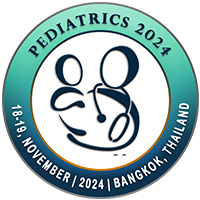
Aysegul EFE
Turkish Ministry of Health, TurkeyTitle: SARS-CoV-2/COVID-19 associated pediatric acute-onset neuropsychiatric syndrome: A Case Report of female twin adolescents
Abstract
The coincidence of myasthenia gravis (MG) and psychiatric symptoms/disorders should not be ignored given the high rates of comorbidity and reciprocal influence of conditions on either clinical course or treatment. To the best of our knowledge, this is the first pediatric case report of a Juvenile MG (JMG) with thymus hyperplasia, a unilateral periventricular nodular heterotrophy (PNH) at lateral ventricle quite closed to basal ganglia and severe psychiatric comorbidity complex including affective and neurodevelopmental disorders such as major depression, anxiety, and tic disorders, as well as a suspicious background of ADHD and learning disabilities. A girl in her late adolescence applied with severely increasing depressive and anxiety symptoms over the past 2 months, on a chronic and complex motor tic disorder background for 2 years. Also, severe somatic and vegetative symptoms such as loss of appetite, restrictive food intake, weight loss (from 55 kg to 43 kg in 2 months, BMI: 15.9 kg/m²), cachexia, recurrent tension-type headaches with the analgesic response, feebleness, lassitude, and sleep disturbances. Her tic symptoms had been clonic, plural, complex (motor and vocal tics), and sequentially wandering around mimic muscles with the sensory phenomenon. A jaw tremor with difficulty in speaking (a nasone and shaky talk), fear of inability to swallow, facial hypomimy, general muscle weakness (also weakness raising eyebrows), and fatigue increasing gradually during the day, and astonishing, transient ptosis of right eyelid were detected in longitudinal psychiatric examinations. There is myotonia in repeating openings of the hands (without tongue involvement). Subsequently, the diagnosis of JMG and concomitant neuropsychiatric conditions (possibly a PANS) such as chronic complex primary tic disorder, major depression, and generalized anxiety disorders were recognized, which were accompanied by thymus hyperplasia and PNH. The treatment was started as pyridostigmine (240 mg/day), prednisone (2 mg/day), and psychotropic drugs including fluoxetine (40 mg/day) and aripiprazole (15 mg/day). The best improvement of depressive symptoms was observed with venlafaxine (SNRI). The patient was weekly followed up, and significant improvement in psychiatric symptoms and also in social functionality after 2 months of therapy was observed. After invasive and surgical interventions including IVIG and thymectomy, the depressive symptoms and social functionality of the patients have been fluctuating for 3 years, possibly due to the psychosocial burdens of having a chronic illness. This female adolescent with JMG, who was followed closely for 3 years with a multidisciplinary treatment approach, may contribute to the literature as a beneficial example for guiding the further examination and management of JMG with severe, complex psychiatric comorbidities, and for demonstrating the positive effects of intravenous immunoglobulin treatment and thymectomy along with proper psychotropic use on both psychiatric and neurological course, as well as for providing insights to clinicians about the presence of possible CNS-malformations.
Biography
Aysegul EFE completed her medical education at Hacettepe University, Faculty of Medicine (Department of English Medicine), and her doctorate at Ankara University, Faculty of Medicine, Department of Child and Adolescent Psychiatry. She is still working as an Associated Professor in the Department of Child and Adolescent Psychiatry and as the head of the Multidisciplinary Child and Adolescent Center, at Ankara Etlik City Hospital of the Turkish Ministry of Health. She has lots of multidisciplinary research on both psychiatry and pediatrics, such as oxidative stress-related etiology of autism spectrum disorders, phenotypes in pediatric obsessive-compulsive disorder, psychiatric comorbidities in Celiac disease, etc.

